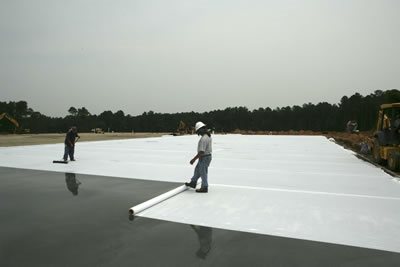
Concreting is the process of concrete batching, mixing, transporting, placing, compacting and in place etc. and it’s the most essential procedure for each and every construction for its quality and durability. The concreting procedure is affected by the temperature, humidity and other environmental factors. Different precaution needs to be exercised when you are concreting it or in the hot weather concreting. If you want to work in such situations or condition than you have to take precautions.
Here we are going to describe the hot weather concreting. The knowledge about hot weather concreting is most essential in the areas with extremely high ambient temperatures, such as in the Arabian Peninsula. It may be necessary to cool the concrete prior to placing it, for example by replacing part of the water in the mix with flaked ice or in many other ways.
If you want to know a general procedure such as batching, mixing, transportation, placing and compaction, than you can get the information in our previous articles.

Hot Weather Concreting
What Temperature is too Hot for Concreting?
Hot weather conditions are commonly encountered in summer, but it’s also a combination of other climatic factors such as high wind velocity, low humidity and solar radiation which can occur at any time or in any season especially in arid and tropical climate.
The definition of hot weather may change from nation to nation depending upon local codal provision, which are defined after study of local conditions.
According to Indian code (IS: 7861 (Part I): 1175), hot weather condition arises when any of the operations of concreting is done at atmospheric temperatures above 40°C or 104°F and any of the operation of concreting (excluding steam curing) where the temperature of concrete at the time of its placement is expected to be beyond 40°C or 104°F.
According to Australian standard (AS 13791), hot weather condition arises when placing of concrete is done at air temperature above 30°C and the maximum concrete temperature is above a 35°C.
According to the National Ready-Mix Concrete Association (USA), “Hot weather, as define by ACI 305R, is any combination of the following conditions that tends to impair the quality of freshly mixed or hardened concrete by accelerating the rate of moisture loss and rate of cement hydration, or otherwise causing detrimental results due to.
- High ambient temperature
- High concrete temperature
- Low relative humidity
- Solar radiation
How the High Temperature Can Affect the Concrete?
You read in a previous article named “Cold Weather Concreting”, how low-temperature effect concrete. Similarly, high temperature also has effect on concrete. In the fresh concrete, high atmospheric temperature increases the temperature of concrete. Due to this the rate of hydration increases and it leads to accelerated setting. High temperature leads to rapid evaporation of moisture from exposed surfaces and it may cause plastic shrinkage cracking and crazing, and subsequent cooling of hardened concrete can introduce tensile stress. Thus, the special attention has to be paid to curing in the hot weather concreting than under normal ambient conditions. In the hot weather concreting water demand increases which will increase water-cement ratio and in turn lower potential strength. It also tends to accelerate loss of slump or workability of concrete and make it difficult to place and will affect finish of concrete.
Effects of Hot Weather on Concrete
01. Early Setting or Stiffening of Concrete
As discussed above, In the hot weather concreting due to the higher temperature, the setting time of concrete will be reduced and will result in the early stiffening and loss of slump or workability. It gives the poor quality of hydration and will suffer a certain loss of long-term strength. Partially set concrete may reduce the bond between the consecutive lifts more than anticipated and also give an adverse effect on placing and finishing of concrete.
02. Evaporation of Mixing Water
Hot weather concreting is normally associated with lower relative humidity. Due to this, the water mixed with the concrete to give the required workability will be lost. With the result, concrete turns in to unworkable and therefore an excessive amount of compaction is required to compact concrete fully. If this is not done, large voids will remain in the concrete, which are responsible for all the ills and problems in concrete.
03. Workability or Sump of Concrete
Loss of workability or slump due to high temperature is the major difficulty that arises with hot weather concreting. It affects the concreting operations like placing, compaction and finishing. Addition of extra water to improve the workability or slump of the concrete mix decreases the strength and increases the permeability, and ultimately affect the durability of the concrete.
04. Compressive Strength
Hot weather concreting increases the water demand due to high temperature. Both can reduce the 28-days strength of concrete. By adding more water to maintain workability, it increases the water-cement ratio and results in loss of strength and durability. It may also increase the drying shrinkage of the hardened concrete.
05. Less Time for Finishing
Finishing of concrete work must be done as early as possible after placing of concrete particularly in the hot weather concreting. In certain cases, if early finishing is not possible due to faster stiffening or setting and quicker evaporation of water, the quality of finishing will be of poor standard. Generally, extra fresh mortar is required to be applied for finishing which results in poor performance.
06. Absorption of Water
In hot weather regions, the sub grade or formwork is normally dry and absorptive. Thus, the sub grade or surface of formwork is required to be wetted before placing the concrete. If this is not done carefully and with proper concern, the water in the concrete may be lost by absorption by the surface in contact with concrete making the contact zone poorer in quality
07. Curing of Concrete
For the hot weather concreting, early curing becomes necessary because hot weather requires a continuous effort for curing of concrete. If there is any interval or interruption than it makes concrete surface dry fast and interrupts the continuous hydration which gives an adverse effect on the development of its full strength.
08. Plastic Shrinkage Cracking
In the hot weather concreting, hot weather accelerates the loss of moisture from the surface. If the evaporation rate is greater than the bleeding rate, it makes the surface dry resulting in shrinkage of the concrete. Cracking occurs when the shrinkage stresses exceed the tensile capacity of the concrete. Plastic shrinkage cracks may be quite deep and continue to widen until the shrinkage stresses are relieved.

Plastic Shrinkage Crack
09. Thermal Cracking
Thermal cracking is a result of the thermal gradient. When concrete is placed, the heat of hydration increases the interior temperature of the concrete. On another side, due to rapid changes in the temperature of the external concrete surface i.e. when concrete slabs, pavements or walls are placed on a hot day followed by a cool night, it may lead to thermal gradient between the hot interior of concrete and the colder external surface of the concrete. The hotter interior provides a restraint to the colder external surface, which wants to contract, which will lead to thermal cracks.
Points/ Precautions to Remember While Hot Weather Concreting
01. Pre-Preparation of Hot Weather Concreting
- Make a proper schedule for hot weather concreting. The concreting can be done in time when the temperature is not high such as it can be scheduled in the early morning in the day time or in late afternoon when the ambient temperature is low.
- For hot weather concreting, provide sufficient labour and machinery to minimize the time required to place and finish the concrete, as hot weather conditions has considerably short time for initial and final set of concrete.
- Erect temporary windbreakers to limit wind velocities.
- Erect sunshades to reduce the temperature of the concrete surface.
- Keep all the stocks (ingredient like fine and coarse aggregate) as cool as possible by making the shades on the stocks and the sprinkling of water on the stocks. (See that water-cement ratio does not increase.)
- For the hot weather concreting, moisten the sub grade, steel reinforcement, and formwork before concrete placement to reduce water absorption from concrete mix.
02. Material and Mix Proportions for Hot Weather Concreting
- For hot weather concreting, use material and mix design proportion having good weather resistance i.e. select sand having low specific heat and so on.
- Use concrete having adequate consistency that allows rapid placement and consolidation.
- To reduce the initial temperature of concrete, use cool aggregates and cool water/ice in hot weather concreting. (Take care to see that water-cement ratio does not increase.)
- In the hot weather concreting, aggregate temperature can be maintained by watering or keeping them covered.
- Use of low heat cement is preferable for hot weather concreting.
- Use of retarding admixtures to counter premature stiffening or setting of the fresh mix for hot weather concreting.
03. Pouring Concrete
- During the hot weather concreting, protect the concrete surface with plastic sheeting or use evaporation retarders to maintain the initial moisture in the concrete mixture.
- Hot weather concreting might be done in a covered environment.
- Use cooling containers, pipelines, chutes, etc. during the transportation of wet concrete.
- During hot weather concreting, complete the concreting operations like transporting, placing and finishing of concrete as fast as is practicable or possible.
- During the hot weather concreting, immediately follow the initial finishing, spraying a fine film of aliphatic alcohol over the exposed concrete for reducing the evaporation of water.

Plastic Sheeting
04. Curing
- In hot weather concreting, consider fogging the area above the concrete placement to raise the relative humidity and satisfy moisture demand of the ambient air.
- For hot weather concreting, provide appropriate curing methods as soon as possible after the finishing of concrete.
- You can use the more efficient way for curing than the water curing in hot weather concreting such as curing blankets, plastic sheets and concrete curing compounds.
Knowledge about hot weather concreting provides guidance on the effects of hot weather conditions on the properties of concrete and the precautions that are to be taken to minimize any potential adverse effects when placing concrete and maintain the quality and durability of construction under such conditions.
Also Read:
8 Basic Causes of Cracks in House
8 Factors Affecting Initial Shrinkage in Concrete & Mortar
5 Right Steps for Repairing of Concrete
Image Courtesy: Image 1(a) – darwenvale.com , Image 1(b), Image 2, Image 3





































